Business Strategy for Unilever: PESTLE, SWOT, Porter's Five Forces, and Porter's Generic Strategy
VerifiedAdded on 2023/06/07
|16
|5090
|53
AI Summary
This report analyses Unilever's business strategies using PESTLE, SWOT, Porter's Five Forces, and Porter's Generic Strategy. It includes identification of competitive advantages and valid strategies to achieve overall strategic objectives.
Contribute Materials
Your contribution can guide someone’s learning journey. Share your
documents today.
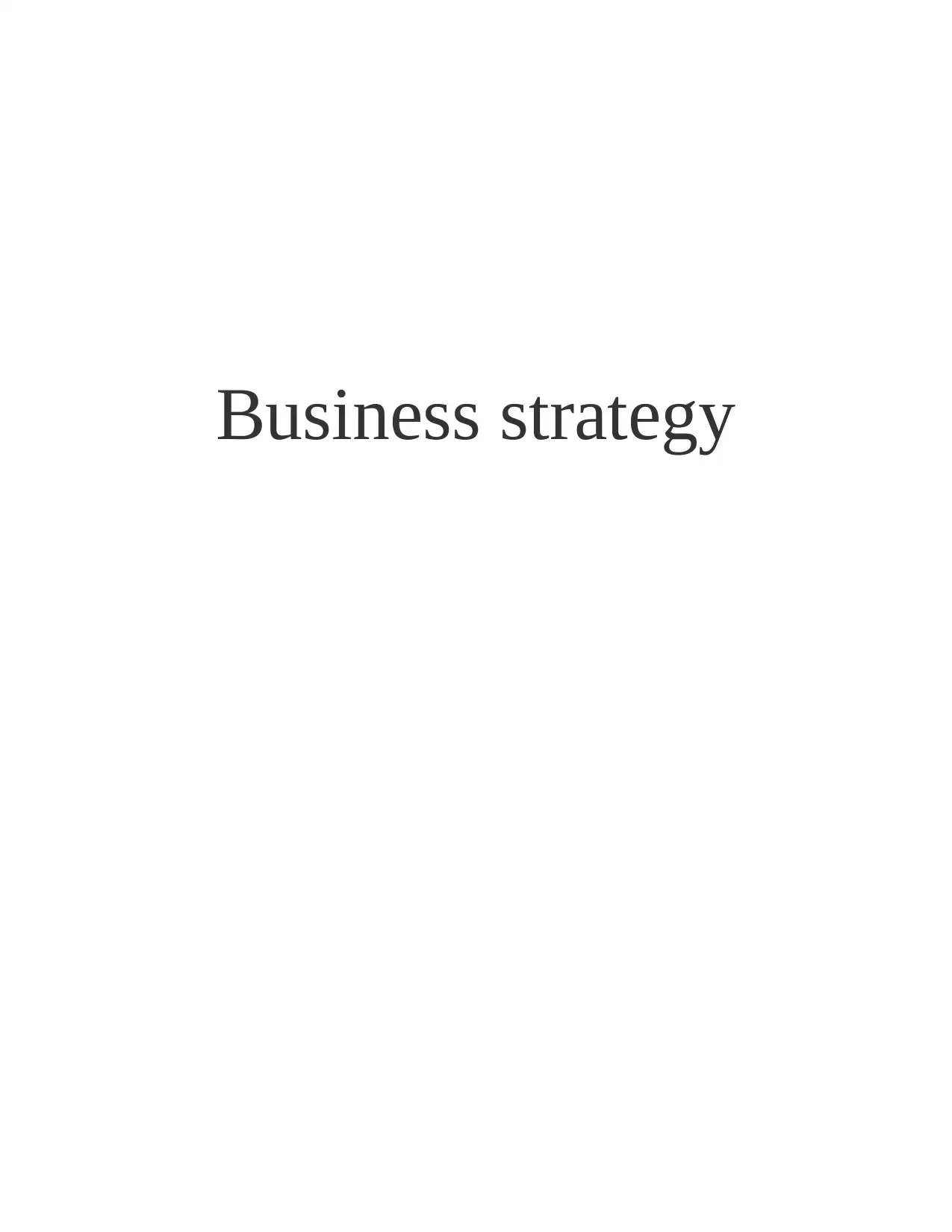
Business strategy
Secure Best Marks with AI Grader
Need help grading? Try our AI Grader for instant feedback on your assignments.
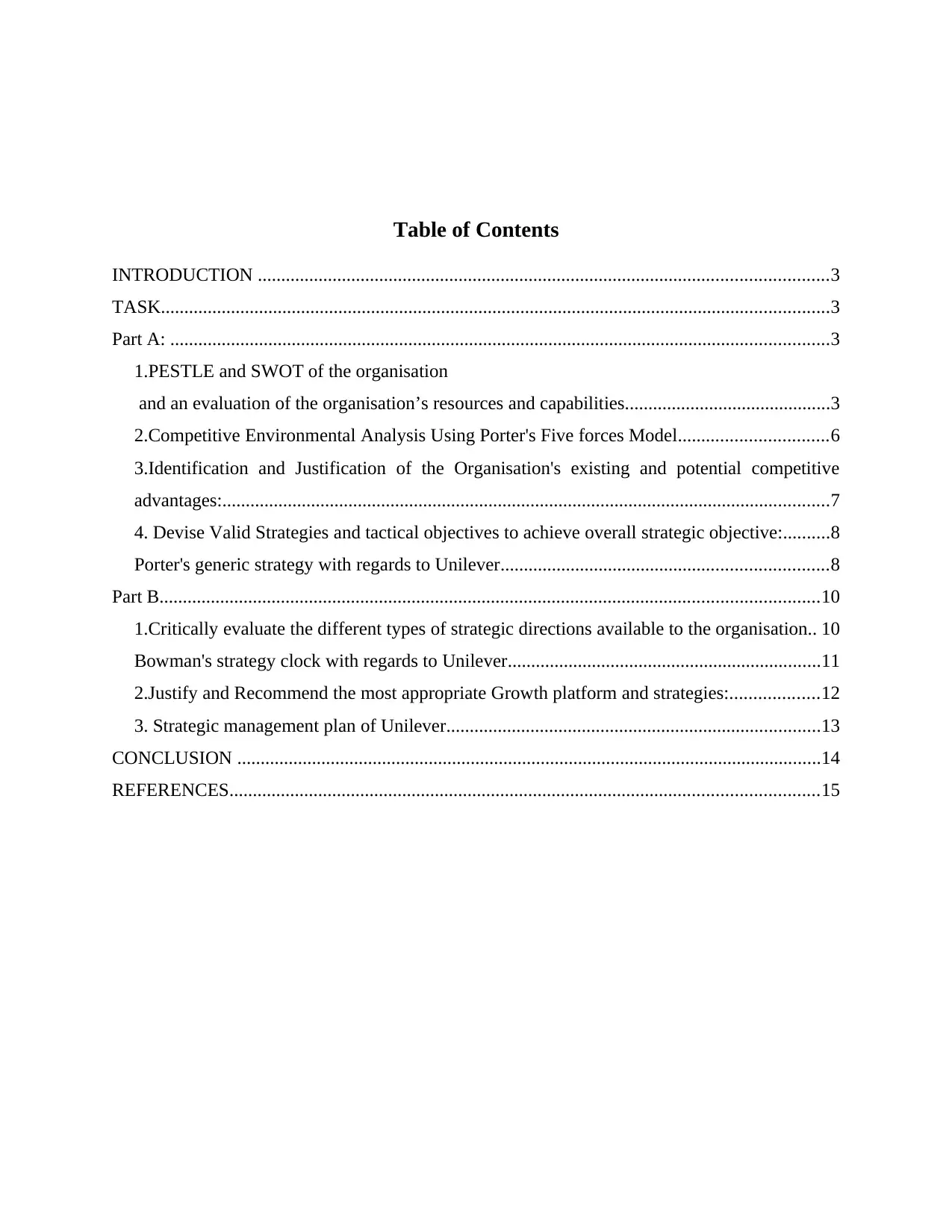
Table of Contents
INTRODUCTION ..........................................................................................................................3
TASK...............................................................................................................................................3
Part A: .............................................................................................................................................3
1.PESTLE and SWOT of the organisation
and an evaluation of the organisation’s resources and capabilities............................................3
2.Competitive Environmental Analysis Using Porter's Five forces Model................................6
3.Identification and Justification of the Organisation's existing and potential competitive
advantages:..................................................................................................................................7
4. Devise Valid Strategies and tactical objectives to achieve overall strategic objective:..........8
Porter's generic strategy with regards to Unilever......................................................................8
Part B.............................................................................................................................................10
1.Critically evaluate the different types of strategic directions available to the organisation.. 10
Bowman's strategy clock with regards to Unilever...................................................................11
2.Justify and Recommend the most appropriate Growth platform and strategies:...................12
3. Strategic management plan of Unilever................................................................................13
CONCLUSION .............................................................................................................................14
REFERENCES..............................................................................................................................15
INTRODUCTION ..........................................................................................................................3
TASK...............................................................................................................................................3
Part A: .............................................................................................................................................3
1.PESTLE and SWOT of the organisation
and an evaluation of the organisation’s resources and capabilities............................................3
2.Competitive Environmental Analysis Using Porter's Five forces Model................................6
3.Identification and Justification of the Organisation's existing and potential competitive
advantages:..................................................................................................................................7
4. Devise Valid Strategies and tactical objectives to achieve overall strategic objective:..........8
Porter's generic strategy with regards to Unilever......................................................................8
Part B.............................................................................................................................................10
1.Critically evaluate the different types of strategic directions available to the organisation.. 10
Bowman's strategy clock with regards to Unilever...................................................................11
2.Justify and Recommend the most appropriate Growth platform and strategies:...................12
3. Strategic management plan of Unilever................................................................................13
CONCLUSION .............................................................................................................................14
REFERENCES..............................................................................................................................15
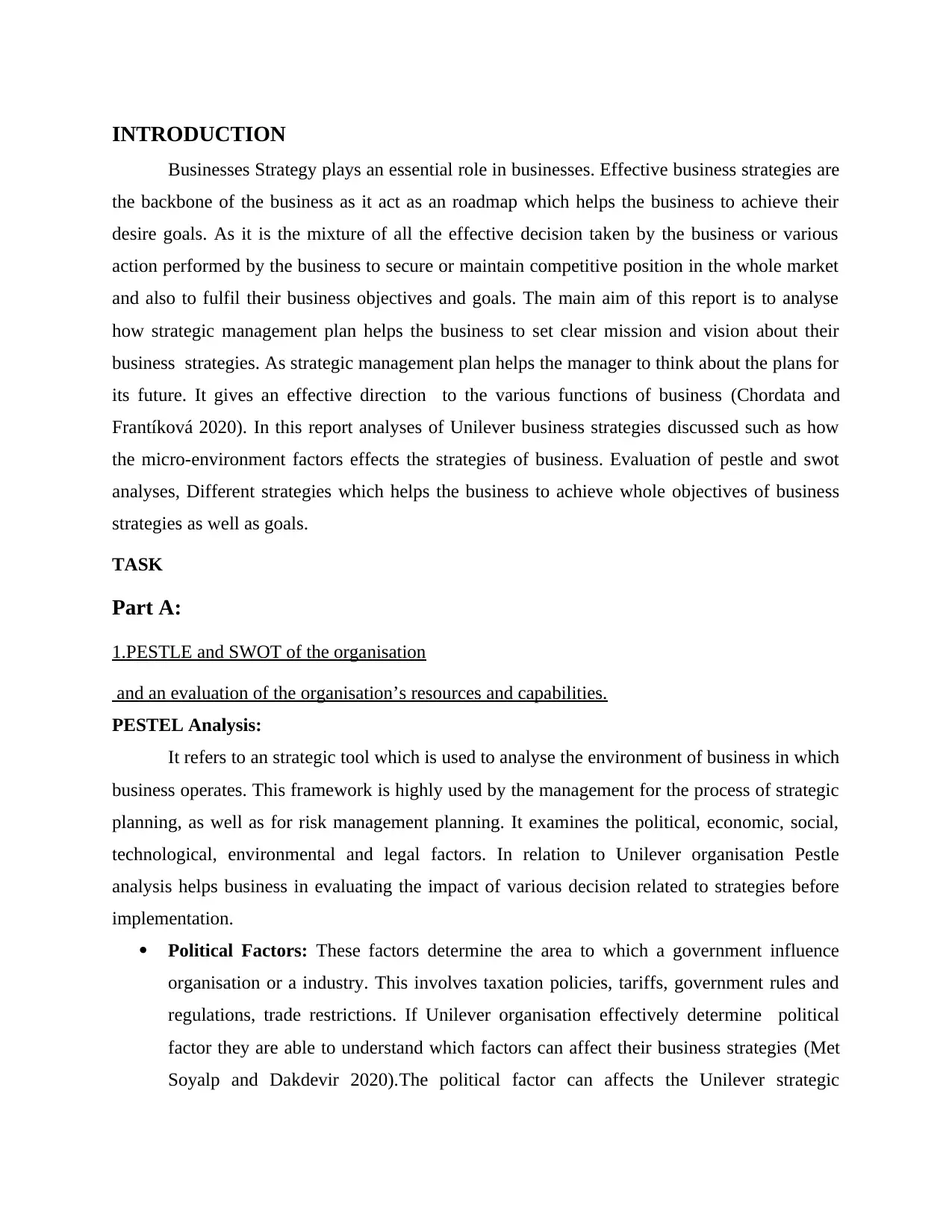
INTRODUCTION
Businesses Strategy plays an essential role in businesses. Effective business strategies are
the backbone of the business as it act as an roadmap which helps the business to achieve their
desire goals. As it is the mixture of all the effective decision taken by the business or various
action performed by the business to secure or maintain competitive position in the whole market
and also to fulfil their business objectives and goals. The main aim of this report is to analyse
how strategic management plan helps the business to set clear mission and vision about their
business strategies. As strategic management plan helps the manager to think about the plans for
its future. It gives an effective direction to the various functions of business (Chordata and
Frantíková 2020). In this report analyses of Unilever business strategies discussed such as how
the micro-environment factors effects the strategies of business. Evaluation of pestle and swot
analyses, Different strategies which helps the business to achieve whole objectives of business
strategies as well as goals.
TASK
Part A:
1.PESTLE and SWOT of the organisation
and an evaluation of the organisation’s resources and capabilities.
PESTEL Analysis:
It refers to an strategic tool which is used to analyse the environment of business in which
business operates. This framework is highly used by the management for the process of strategic
planning, as well as for risk management planning. It examines the political, economic, social,
technological, environmental and legal factors. In relation to Unilever organisation Pestle
analysis helps business in evaluating the impact of various decision related to strategies before
implementation.
Political Factors: These factors determine the area to which a government influence
organisation or a industry. This involves taxation policies, tariffs, government rules and
regulations, trade restrictions. If Unilever organisation effectively determine political
factor they are able to understand which factors can affect their business strategies (Met
Soyalp and Dakdevir 2020).The political factor can affects the Unilever strategic
Businesses Strategy plays an essential role in businesses. Effective business strategies are
the backbone of the business as it act as an roadmap which helps the business to achieve their
desire goals. As it is the mixture of all the effective decision taken by the business or various
action performed by the business to secure or maintain competitive position in the whole market
and also to fulfil their business objectives and goals. The main aim of this report is to analyse
how strategic management plan helps the business to set clear mission and vision about their
business strategies. As strategic management plan helps the manager to think about the plans for
its future. It gives an effective direction to the various functions of business (Chordata and
Frantíková 2020). In this report analyses of Unilever business strategies discussed such as how
the micro-environment factors effects the strategies of business. Evaluation of pestle and swot
analyses, Different strategies which helps the business to achieve whole objectives of business
strategies as well as goals.
TASK
Part A:
1.PESTLE and SWOT of the organisation
and an evaluation of the organisation’s resources and capabilities.
PESTEL Analysis:
It refers to an strategic tool which is used to analyse the environment of business in which
business operates. This framework is highly used by the management for the process of strategic
planning, as well as for risk management planning. It examines the political, economic, social,
technological, environmental and legal factors. In relation to Unilever organisation Pestle
analysis helps business in evaluating the impact of various decision related to strategies before
implementation.
Political Factors: These factors determine the area to which a government influence
organisation or a industry. This involves taxation policies, tariffs, government rules and
regulations, trade restrictions. If Unilever organisation effectively determine political
factor they are able to understand which factors can affect their business strategies (Met
Soyalp and Dakdevir 2020).The political factor can affects the Unilever strategic
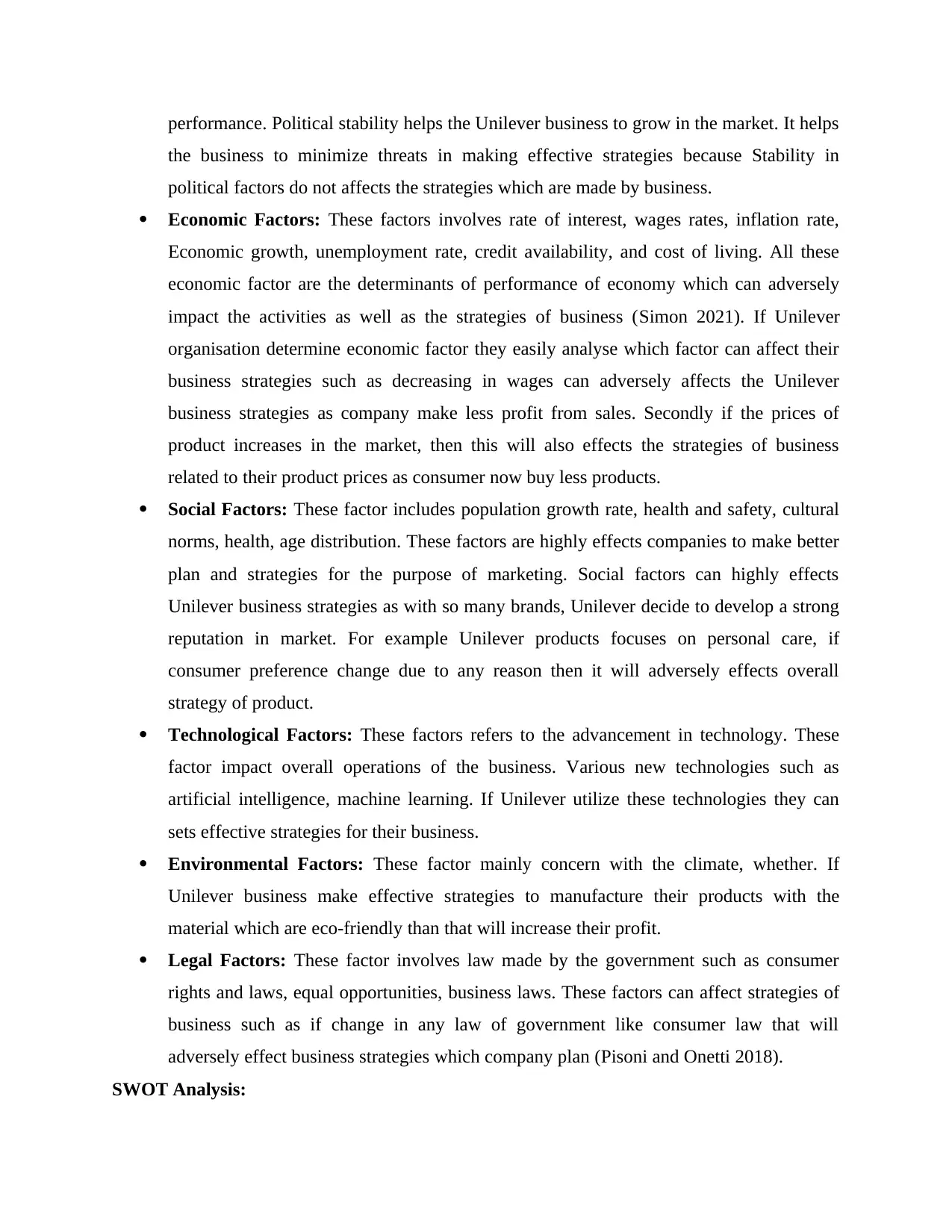
performance. Political stability helps the Unilever business to grow in the market. It helps
the business to minimize threats in making effective strategies because Stability in
political factors do not affects the strategies which are made by business.
Economic Factors: These factors involves rate of interest, wages rates, inflation rate,
Economic growth, unemployment rate, credit availability, and cost of living. All these
economic factor are the determinants of performance of economy which can adversely
impact the activities as well as the strategies of business (Simon 2021). If Unilever
organisation determine economic factor they easily analyse which factor can affect their
business strategies such as decreasing in wages can adversely affects the Unilever
business strategies as company make less profit from sales. Secondly if the prices of
product increases in the market, then this will also effects the strategies of business
related to their product prices as consumer now buy less products.
Social Factors: These factor includes population growth rate, health and safety, cultural
norms, health, age distribution. These factors are highly effects companies to make better
plan and strategies for the purpose of marketing. Social factors can highly effects
Unilever business strategies as with so many brands, Unilever decide to develop a strong
reputation in market. For example Unilever products focuses on personal care, if
consumer preference change due to any reason then it will adversely effects overall
strategy of product.
Technological Factors: These factors refers to the advancement in technology. These
factor impact overall operations of the business. Various new technologies such as
artificial intelligence, machine learning. If Unilever utilize these technologies they can
sets effective strategies for their business.
Environmental Factors: These factor mainly concern with the climate, whether. If
Unilever business make effective strategies to manufacture their products with the
material which are eco-friendly than that will increase their profit.
Legal Factors: These factor involves law made by the government such as consumer
rights and laws, equal opportunities, business laws. These factors can affect strategies of
business such as if change in any law of government like consumer law that will
adversely effect business strategies which company plan (Pisoni and Onetti 2018).
SWOT Analysis:
the business to minimize threats in making effective strategies because Stability in
political factors do not affects the strategies which are made by business.
Economic Factors: These factors involves rate of interest, wages rates, inflation rate,
Economic growth, unemployment rate, credit availability, and cost of living. All these
economic factor are the determinants of performance of economy which can adversely
impact the activities as well as the strategies of business (Simon 2021). If Unilever
organisation determine economic factor they easily analyse which factor can affect their
business strategies such as decreasing in wages can adversely affects the Unilever
business strategies as company make less profit from sales. Secondly if the prices of
product increases in the market, then this will also effects the strategies of business
related to their product prices as consumer now buy less products.
Social Factors: These factor includes population growth rate, health and safety, cultural
norms, health, age distribution. These factors are highly effects companies to make better
plan and strategies for the purpose of marketing. Social factors can highly effects
Unilever business strategies as with so many brands, Unilever decide to develop a strong
reputation in market. For example Unilever products focuses on personal care, if
consumer preference change due to any reason then it will adversely effects overall
strategy of product.
Technological Factors: These factors refers to the advancement in technology. These
factor impact overall operations of the business. Various new technologies such as
artificial intelligence, machine learning. If Unilever utilize these technologies they can
sets effective strategies for their business.
Environmental Factors: These factor mainly concern with the climate, whether. If
Unilever business make effective strategies to manufacture their products with the
material which are eco-friendly than that will increase their profit.
Legal Factors: These factor involves law made by the government such as consumer
rights and laws, equal opportunities, business laws. These factors can affect strategies of
business such as if change in any law of government like consumer law that will
adversely effect business strategies which company plan (Pisoni and Onetti 2018).
SWOT Analysis:
Secure Best Marks with AI Grader
Need help grading? Try our AI Grader for instant feedback on your assignments.
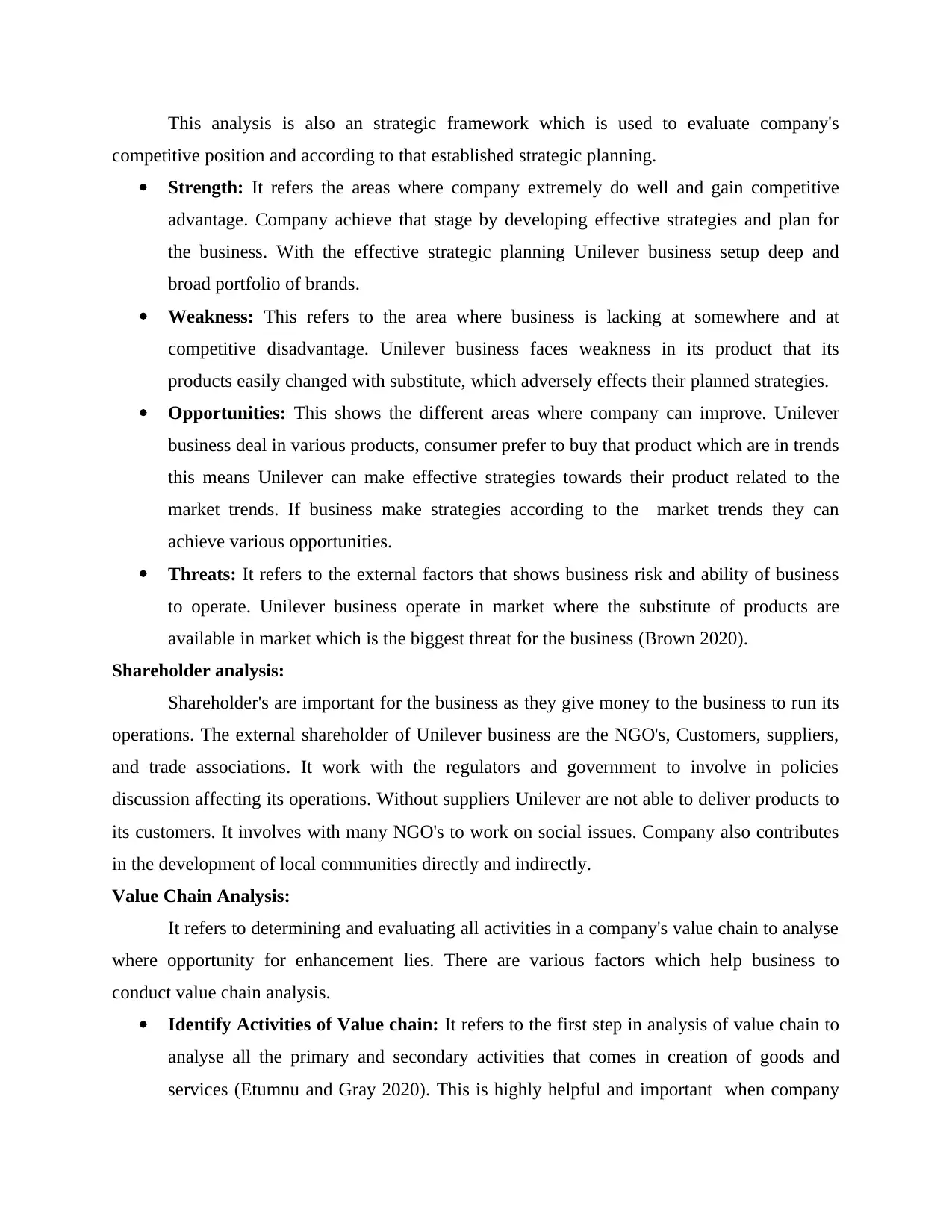
This analysis is also an strategic framework which is used to evaluate company's
competitive position and according to that established strategic planning.
Strength: It refers the areas where company extremely do well and gain competitive
advantage. Company achieve that stage by developing effective strategies and plan for
the business. With the effective strategic planning Unilever business setup deep and
broad portfolio of brands.
Weakness: This refers to the area where business is lacking at somewhere and at
competitive disadvantage. Unilever business faces weakness in its product that its
products easily changed with substitute, which adversely effects their planned strategies.
Opportunities: This shows the different areas where company can improve. Unilever
business deal in various products, consumer prefer to buy that product which are in trends
this means Unilever can make effective strategies towards their product related to the
market trends. If business make strategies according to the market trends they can
achieve various opportunities.
Threats: It refers to the external factors that shows business risk and ability of business
to operate. Unilever business operate in market where the substitute of products are
available in market which is the biggest threat for the business (Brown 2020).
Shareholder analysis:
Shareholder's are important for the business as they give money to the business to run its
operations. The external shareholder of Unilever business are the NGO's, Customers, suppliers,
and trade associations. It work with the regulators and government to involve in policies
discussion affecting its operations. Without suppliers Unilever are not able to deliver products to
its customers. It involves with many NGO's to work on social issues. Company also contributes
in the development of local communities directly and indirectly.
Value Chain Analysis:
It refers to determining and evaluating all activities in a company's value chain to analyse
where opportunity for enhancement lies. There are various factors which help business to
conduct value chain analysis.
Identify Activities of Value chain: It refers to the first step in analysis of value chain to
analyse all the primary and secondary activities that comes in creation of goods and
services (Etumnu and Gray 2020). This is highly helpful and important when company
competitive position and according to that established strategic planning.
Strength: It refers the areas where company extremely do well and gain competitive
advantage. Company achieve that stage by developing effective strategies and plan for
the business. With the effective strategic planning Unilever business setup deep and
broad portfolio of brands.
Weakness: This refers to the area where business is lacking at somewhere and at
competitive disadvantage. Unilever business faces weakness in its product that its
products easily changed with substitute, which adversely effects their planned strategies.
Opportunities: This shows the different areas where company can improve. Unilever
business deal in various products, consumer prefer to buy that product which are in trends
this means Unilever can make effective strategies towards their product related to the
market trends. If business make strategies according to the market trends they can
achieve various opportunities.
Threats: It refers to the external factors that shows business risk and ability of business
to operate. Unilever business operate in market where the substitute of products are
available in market which is the biggest threat for the business (Brown 2020).
Shareholder analysis:
Shareholder's are important for the business as they give money to the business to run its
operations. The external shareholder of Unilever business are the NGO's, Customers, suppliers,
and trade associations. It work with the regulators and government to involve in policies
discussion affecting its operations. Without suppliers Unilever are not able to deliver products to
its customers. It involves with many NGO's to work on social issues. Company also contributes
in the development of local communities directly and indirectly.
Value Chain Analysis:
It refers to determining and evaluating all activities in a company's value chain to analyse
where opportunity for enhancement lies. There are various factors which help business to
conduct value chain analysis.
Identify Activities of Value chain: It refers to the first step in analysis of value chain to
analyse all the primary and secondary activities that comes in creation of goods and
services (Etumnu and Gray 2020). This is highly helpful and important when company
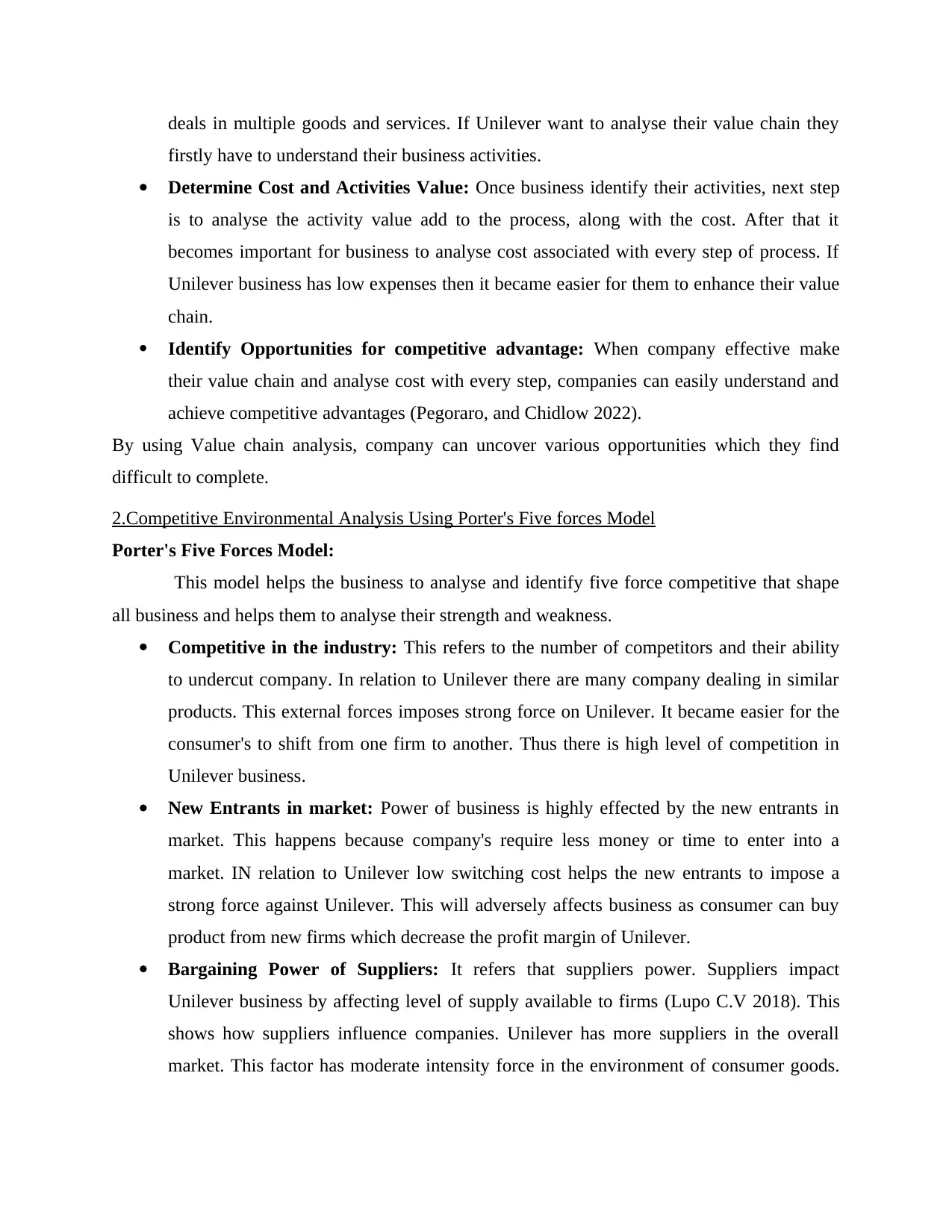
deals in multiple goods and services. If Unilever want to analyse their value chain they
firstly have to understand their business activities.
Determine Cost and Activities Value: Once business identify their activities, next step
is to analyse the activity value add to the process, along with the cost. After that it
becomes important for business to analyse cost associated with every step of process. If
Unilever business has low expenses then it became easier for them to enhance their value
chain.
Identify Opportunities for competitive advantage: When company effective make
their value chain and analyse cost with every step, companies can easily understand and
achieve competitive advantages (Pegoraro, and Chidlow 2022).
By using Value chain analysis, company can uncover various opportunities which they find
difficult to complete.
2.Competitive Environmental Analysis Using Porter's Five forces Model
Porter's Five Forces Model:
This model helps the business to analyse and identify five force competitive that shape
all business and helps them to analyse their strength and weakness.
Competitive in the industry: This refers to the number of competitors and their ability
to undercut company. In relation to Unilever there are many company dealing in similar
products. This external forces imposes strong force on Unilever. It became easier for the
consumer's to shift from one firm to another. Thus there is high level of competition in
Unilever business.
New Entrants in market: Power of business is highly effected by the new entrants in
market. This happens because company's require less money or time to enter into a
market. IN relation to Unilever low switching cost helps the new entrants to impose a
strong force against Unilever. This will adversely affects business as consumer can buy
product from new firms which decrease the profit margin of Unilever.
Bargaining Power of Suppliers: It refers that suppliers power. Suppliers impact
Unilever business by affecting level of supply available to firms (Lupo C.V 2018). This
shows how suppliers influence companies. Unilever has more suppliers in the overall
market. This factor has moderate intensity force in the environment of consumer goods.
firstly have to understand their business activities.
Determine Cost and Activities Value: Once business identify their activities, next step
is to analyse the activity value add to the process, along with the cost. After that it
becomes important for business to analyse cost associated with every step of process. If
Unilever business has low expenses then it became easier for them to enhance their value
chain.
Identify Opportunities for competitive advantage: When company effective make
their value chain and analyse cost with every step, companies can easily understand and
achieve competitive advantages (Pegoraro, and Chidlow 2022).
By using Value chain analysis, company can uncover various opportunities which they find
difficult to complete.
2.Competitive Environmental Analysis Using Porter's Five forces Model
Porter's Five Forces Model:
This model helps the business to analyse and identify five force competitive that shape
all business and helps them to analyse their strength and weakness.
Competitive in the industry: This refers to the number of competitors and their ability
to undercut company. In relation to Unilever there are many company dealing in similar
products. This external forces imposes strong force on Unilever. It became easier for the
consumer's to shift from one firm to another. Thus there is high level of competition in
Unilever business.
New Entrants in market: Power of business is highly effected by the new entrants in
market. This happens because company's require less money or time to enter into a
market. IN relation to Unilever low switching cost helps the new entrants to impose a
strong force against Unilever. This will adversely affects business as consumer can buy
product from new firms which decrease the profit margin of Unilever.
Bargaining Power of Suppliers: It refers that suppliers power. Suppliers impact
Unilever business by affecting level of supply available to firms (Lupo C.V 2018). This
shows how suppliers influence companies. Unilever has more suppliers in the overall
market. This factor has moderate intensity force in the environment of consumer goods.
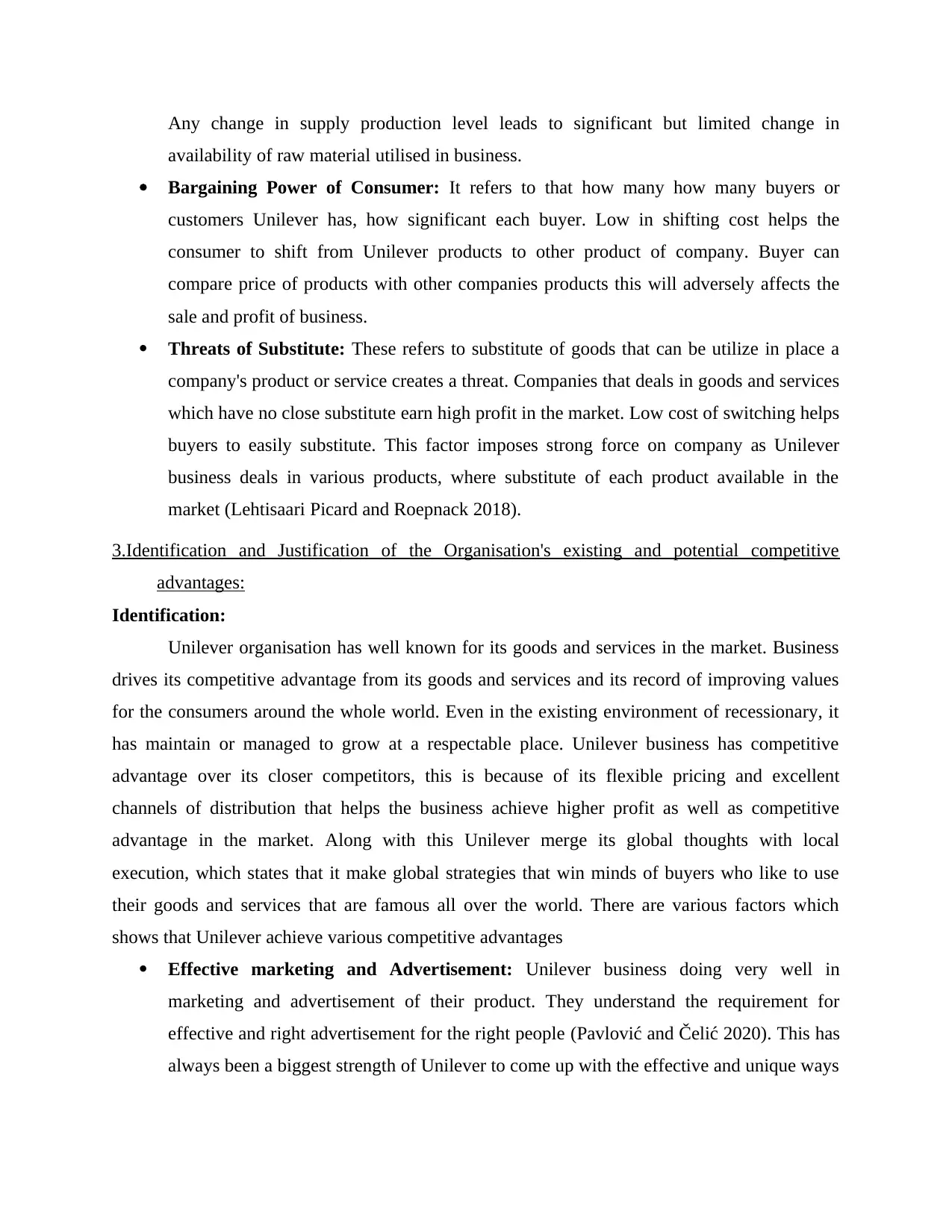
Any change in supply production level leads to significant but limited change in
availability of raw material utilised in business.
Bargaining Power of Consumer: It refers to that how many how many buyers or
customers Unilever has, how significant each buyer. Low in shifting cost helps the
consumer to shift from Unilever products to other product of company. Buyer can
compare price of products with other companies products this will adversely affects the
sale and profit of business.
Threats of Substitute: These refers to substitute of goods that can be utilize in place a
company's product or service creates a threat. Companies that deals in goods and services
which have no close substitute earn high profit in the market. Low cost of switching helps
buyers to easily substitute. This factor imposes strong force on company as Unilever
business deals in various products, where substitute of each product available in the
market (Lehtisaari Picard and Roepnack 2018).
3.Identification and Justification of the Organisation's existing and potential competitive
advantages:
Identification:
Unilever organisation has well known for its goods and services in the market. Business
drives its competitive advantage from its goods and services and its record of improving values
for the consumers around the whole world. Even in the existing environment of recessionary, it
has maintain or managed to grow at a respectable place. Unilever business has competitive
advantage over its closer competitors, this is because of its flexible pricing and excellent
channels of distribution that helps the business achieve higher profit as well as competitive
advantage in the market. Along with this Unilever merge its global thoughts with local
execution, which states that it make global strategies that win minds of buyers who like to use
their goods and services that are famous all over the world. There are various factors which
shows that Unilever achieve various competitive advantages
Effective marketing and Advertisement: Unilever business doing very well in
marketing and advertisement of their product. They understand the requirement for
effective and right advertisement for the right people (Pavlović and Čelić 2020). This has
always been a biggest strength of Unilever to come up with the effective and unique ways
availability of raw material utilised in business.
Bargaining Power of Consumer: It refers to that how many how many buyers or
customers Unilever has, how significant each buyer. Low in shifting cost helps the
consumer to shift from Unilever products to other product of company. Buyer can
compare price of products with other companies products this will adversely affects the
sale and profit of business.
Threats of Substitute: These refers to substitute of goods that can be utilize in place a
company's product or service creates a threat. Companies that deals in goods and services
which have no close substitute earn high profit in the market. Low cost of switching helps
buyers to easily substitute. This factor imposes strong force on company as Unilever
business deals in various products, where substitute of each product available in the
market (Lehtisaari Picard and Roepnack 2018).
3.Identification and Justification of the Organisation's existing and potential competitive
advantages:
Identification:
Unilever organisation has well known for its goods and services in the market. Business
drives its competitive advantage from its goods and services and its record of improving values
for the consumers around the whole world. Even in the existing environment of recessionary, it
has maintain or managed to grow at a respectable place. Unilever business has competitive
advantage over its closer competitors, this is because of its flexible pricing and excellent
channels of distribution that helps the business achieve higher profit as well as competitive
advantage in the market. Along with this Unilever merge its global thoughts with local
execution, which states that it make global strategies that win minds of buyers who like to use
their goods and services that are famous all over the world. There are various factors which
shows that Unilever achieve various competitive advantages
Effective marketing and Advertisement: Unilever business doing very well in
marketing and advertisement of their product. They understand the requirement for
effective and right advertisement for the right people (Pavlović and Čelić 2020). This has
always been a biggest strength of Unilever to come up with the effective and unique ways
Paraphrase This Document
Need a fresh take? Get an instant paraphrase of this document with our AI Paraphraser
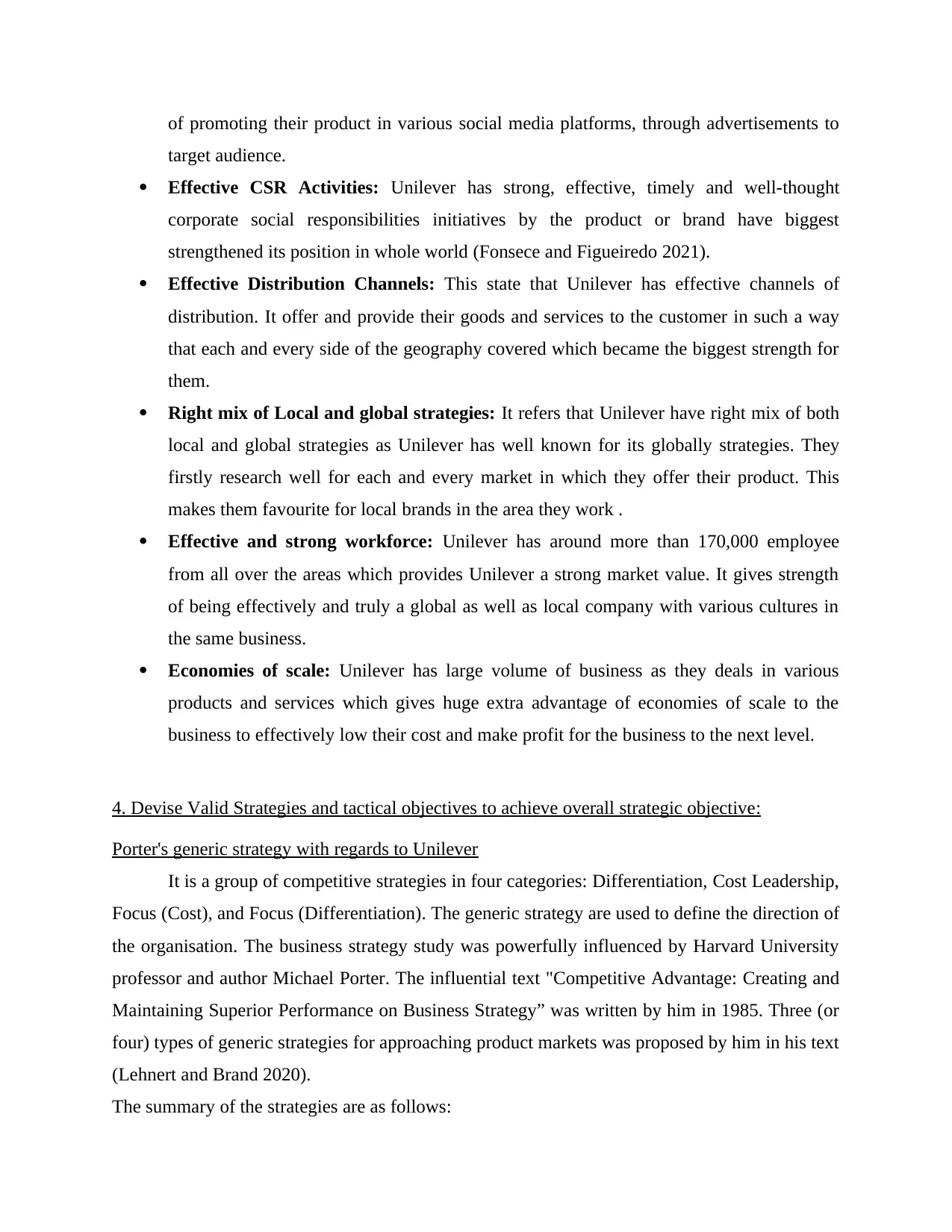
of promoting their product in various social media platforms, through advertisements to
target audience.
Effective CSR Activities: Unilever has strong, effective, timely and well-thought
corporate social responsibilities initiatives by the product or brand have biggest
strengthened its position in whole world (Fonsece and Figueiredo 2021).
Effective Distribution Channels: This state that Unilever has effective channels of
distribution. It offer and provide their goods and services to the customer in such a way
that each and every side of the geography covered which became the biggest strength for
them.
Right mix of Local and global strategies: It refers that Unilever have right mix of both
local and global strategies as Unilever has well known for its globally strategies. They
firstly research well for each and every market in which they offer their product. This
makes them favourite for local brands in the area they work .
Effective and strong workforce: Unilever has around more than 170,000 employee
from all over the areas which provides Unilever a strong market value. It gives strength
of being effectively and truly a global as well as local company with various cultures in
the same business.
Economies of scale: Unilever has large volume of business as they deals in various
products and services which gives huge extra advantage of economies of scale to the
business to effectively low their cost and make profit for the business to the next level.
4. Devise Valid Strategies and tactical objectives to achieve overall strategic objective:
Porter's generic strategy with regards to Unilever
It is a group of competitive strategies in four categories: Differentiation, Cost Leadership,
Focus (Cost), and Focus (Differentiation). The generic strategy are used to define the direction of
the organisation. The business strategy study was powerfully influenced by Harvard University
professor and author Michael Porter. The influential text "Competitive Advantage: Creating and
Maintaining Superior Performance on Business Strategy” was written by him in 1985. Three (or
four) types of generic strategies for approaching product markets was proposed by him in his text
(Lehnert and Brand 2020).
The summary of the strategies are as follows:
target audience.
Effective CSR Activities: Unilever has strong, effective, timely and well-thought
corporate social responsibilities initiatives by the product or brand have biggest
strengthened its position in whole world (Fonsece and Figueiredo 2021).
Effective Distribution Channels: This state that Unilever has effective channels of
distribution. It offer and provide their goods and services to the customer in such a way
that each and every side of the geography covered which became the biggest strength for
them.
Right mix of Local and global strategies: It refers that Unilever have right mix of both
local and global strategies as Unilever has well known for its globally strategies. They
firstly research well for each and every market in which they offer their product. This
makes them favourite for local brands in the area they work .
Effective and strong workforce: Unilever has around more than 170,000 employee
from all over the areas which provides Unilever a strong market value. It gives strength
of being effectively and truly a global as well as local company with various cultures in
the same business.
Economies of scale: Unilever has large volume of business as they deals in various
products and services which gives huge extra advantage of economies of scale to the
business to effectively low their cost and make profit for the business to the next level.
4. Devise Valid Strategies and tactical objectives to achieve overall strategic objective:
Porter's generic strategy with regards to Unilever
It is a group of competitive strategies in four categories: Differentiation, Cost Leadership,
Focus (Cost), and Focus (Differentiation). The generic strategy are used to define the direction of
the organisation. The business strategy study was powerfully influenced by Harvard University
professor and author Michael Porter. The influential text "Competitive Advantage: Creating and
Maintaining Superior Performance on Business Strategy” was written by him in 1985. Three (or
four) types of generic strategies for approaching product markets was proposed by him in his text
(Lehnert and Brand 2020).
The summary of the strategies are as follows:
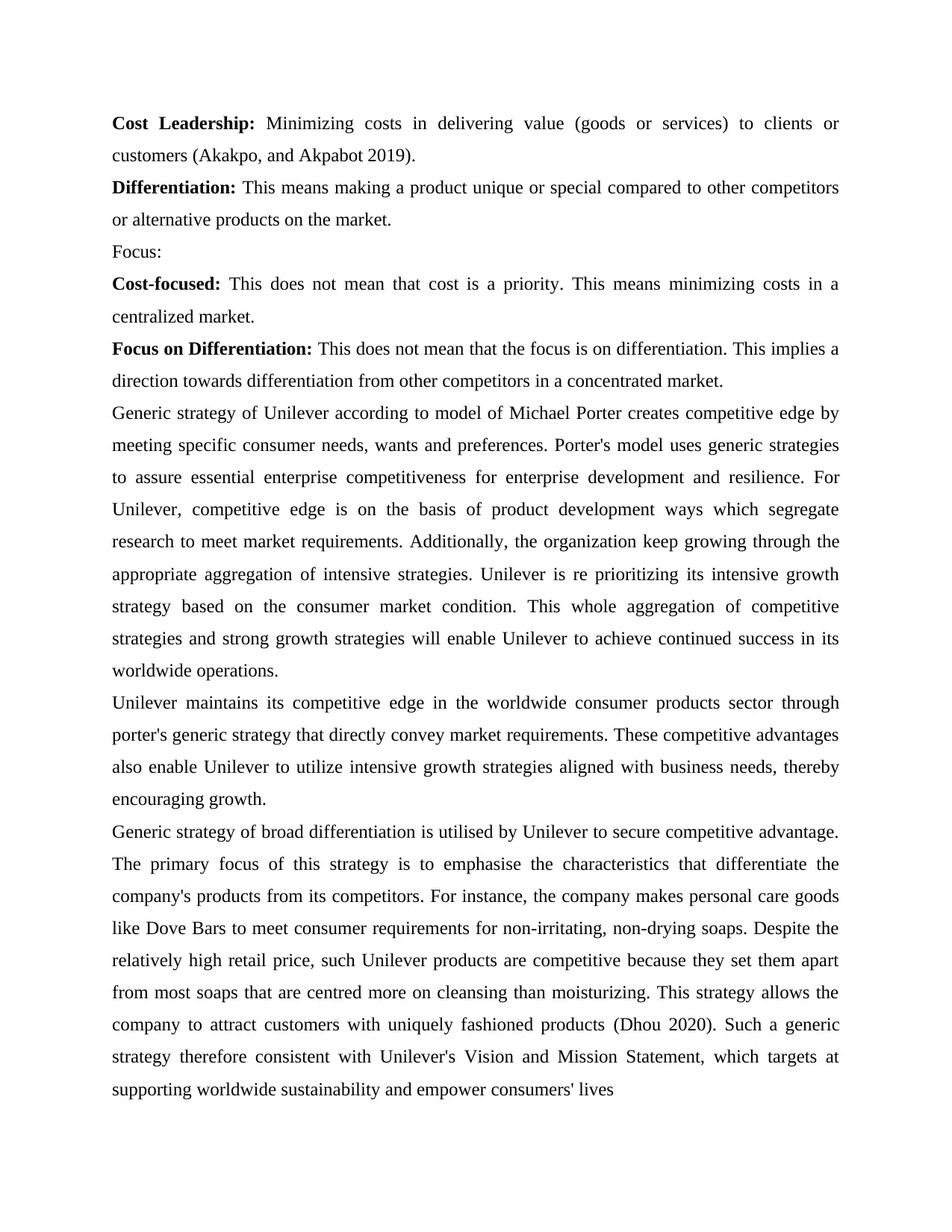
Cost Leadership: Minimizing costs in delivering value (goods or services) to clients or
customers (Akakpo, and Akpabot 2019).
Differentiation: This means making a product unique or special compared to other competitors
or alternative products on the market.
Focus:
Cost-focused: This does not mean that cost is a priority. This means minimizing costs in a
centralized market.
Focus on Differentiation: This does not mean that the focus is on differentiation. This implies a
direction towards differentiation from other competitors in a concentrated market.
Generic strategy of Unilever according to model of Michael Porter creates competitive edge by
meeting specific consumer needs, wants and preferences. Porter's model uses generic strategies
to assure essential enterprise competitiveness for enterprise development and resilience. For
Unilever, competitive edge is on the basis of product development ways which segregate
research to meet market requirements. Additionally, the organization keep growing through the
appropriate aggregation of intensive strategies. Unilever is re prioritizing its intensive growth
strategy based on the consumer market condition. This whole aggregation of competitive
strategies and strong growth strategies will enable Unilever to achieve continued success in its
worldwide operations.
Unilever maintains its competitive edge in the worldwide consumer products sector through
porter's generic strategy that directly convey market requirements. These competitive advantages
also enable Unilever to utilize intensive growth strategies aligned with business needs, thereby
encouraging growth.
Generic strategy of broad differentiation is utilised by Unilever to secure competitive advantage.
The primary focus of this strategy is to emphasise the characteristics that differentiate the
company's products from its competitors. For instance, the company makes personal care goods
like Dove Bars to meet consumer requirements for non-irritating, non-drying soaps. Despite the
relatively high retail price, such Unilever products are competitive because they set them apart
from most soaps that are centred more on cleansing than moisturizing. This strategy allows the
company to attract customers with uniquely fashioned products (Dhou 2020). Such a generic
strategy therefore consistent with Unilever's Vision and Mission Statement, which targets at
supporting worldwide sustainability and empower consumers' lives
customers (Akakpo, and Akpabot 2019).
Differentiation: This means making a product unique or special compared to other competitors
or alternative products on the market.
Focus:
Cost-focused: This does not mean that cost is a priority. This means minimizing costs in a
centralized market.
Focus on Differentiation: This does not mean that the focus is on differentiation. This implies a
direction towards differentiation from other competitors in a concentrated market.
Generic strategy of Unilever according to model of Michael Porter creates competitive edge by
meeting specific consumer needs, wants and preferences. Porter's model uses generic strategies
to assure essential enterprise competitiveness for enterprise development and resilience. For
Unilever, competitive edge is on the basis of product development ways which segregate
research to meet market requirements. Additionally, the organization keep growing through the
appropriate aggregation of intensive strategies. Unilever is re prioritizing its intensive growth
strategy based on the consumer market condition. This whole aggregation of competitive
strategies and strong growth strategies will enable Unilever to achieve continued success in its
worldwide operations.
Unilever maintains its competitive edge in the worldwide consumer products sector through
porter's generic strategy that directly convey market requirements. These competitive advantages
also enable Unilever to utilize intensive growth strategies aligned with business needs, thereby
encouraging growth.
Generic strategy of broad differentiation is utilised by Unilever to secure competitive advantage.
The primary focus of this strategy is to emphasise the characteristics that differentiate the
company's products from its competitors. For instance, the company makes personal care goods
like Dove Bars to meet consumer requirements for non-irritating, non-drying soaps. Despite the
relatively high retail price, such Unilever products are competitive because they set them apart
from most soaps that are centred more on cleansing than moisturizing. This strategy allows the
company to attract customers with uniquely fashioned products (Dhou 2020). Such a generic
strategy therefore consistent with Unilever's Vision and Mission Statement, which targets at
supporting worldwide sustainability and empower consumers' lives
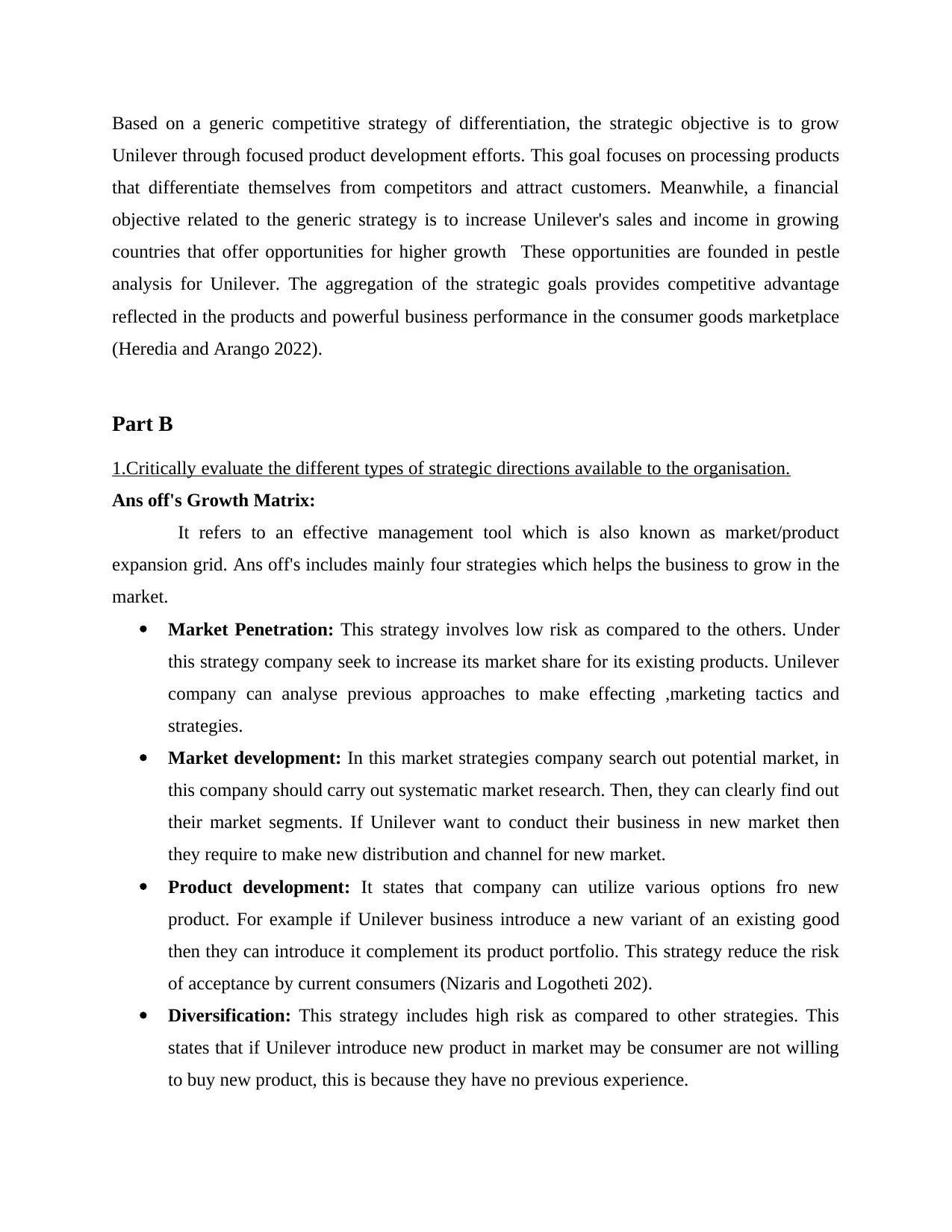
Based on a generic competitive strategy of differentiation, the strategic objective is to grow
Unilever through focused product development efforts. This goal focuses on processing products
that differentiate themselves from competitors and attract customers. Meanwhile, a financial
objective related to the generic strategy is to increase Unilever's sales and income in growing
countries that offer opportunities for higher growth These opportunities are founded in pestle
analysis for Unilever. The aggregation of the strategic goals provides competitive advantage
reflected in the products and powerful business performance in the consumer goods marketplace
(Heredia and Arango 2022).
Part B
1.Critically evaluate the different types of strategic directions available to the organisation.
Ans off's Growth Matrix:
It refers to an effective management tool which is also known as market/product
expansion grid. Ans off's includes mainly four strategies which helps the business to grow in the
market.
Market Penetration: This strategy involves low risk as compared to the others. Under
this strategy company seek to increase its market share for its existing products. Unilever
company can analyse previous approaches to make effecting ,marketing tactics and
strategies.
Market development: In this market strategies company search out potential market, in
this company should carry out systematic market research. Then, they can clearly find out
their market segments. If Unilever want to conduct their business in new market then
they require to make new distribution and channel for new market.
Product development: It states that company can utilize various options fro new
product. For example if Unilever business introduce a new variant of an existing good
then they can introduce it complement its product portfolio. This strategy reduce the risk
of acceptance by current consumers (Nizaris and Logotheti 202).
Diversification: This strategy includes high risk as compared to other strategies. This
states that if Unilever introduce new product in market may be consumer are not willing
to buy new product, this is because they have no previous experience.
Unilever through focused product development efforts. This goal focuses on processing products
that differentiate themselves from competitors and attract customers. Meanwhile, a financial
objective related to the generic strategy is to increase Unilever's sales and income in growing
countries that offer opportunities for higher growth These opportunities are founded in pestle
analysis for Unilever. The aggregation of the strategic goals provides competitive advantage
reflected in the products and powerful business performance in the consumer goods marketplace
(Heredia and Arango 2022).
Part B
1.Critically evaluate the different types of strategic directions available to the organisation.
Ans off's Growth Matrix:
It refers to an effective management tool which is also known as market/product
expansion grid. Ans off's includes mainly four strategies which helps the business to grow in the
market.
Market Penetration: This strategy involves low risk as compared to the others. Under
this strategy company seek to increase its market share for its existing products. Unilever
company can analyse previous approaches to make effecting ,marketing tactics and
strategies.
Market development: In this market strategies company search out potential market, in
this company should carry out systematic market research. Then, they can clearly find out
their market segments. If Unilever want to conduct their business in new market then
they require to make new distribution and channel for new market.
Product development: It states that company can utilize various options fro new
product. For example if Unilever business introduce a new variant of an existing good
then they can introduce it complement its product portfolio. This strategy reduce the risk
of acceptance by current consumers (Nizaris and Logotheti 202).
Diversification: This strategy includes high risk as compared to other strategies. This
states that if Unilever introduce new product in market may be consumer are not willing
to buy new product, this is because they have no previous experience.
Secure Best Marks with AI Grader
Need help grading? Try our AI Grader for instant feedback on your assignments.
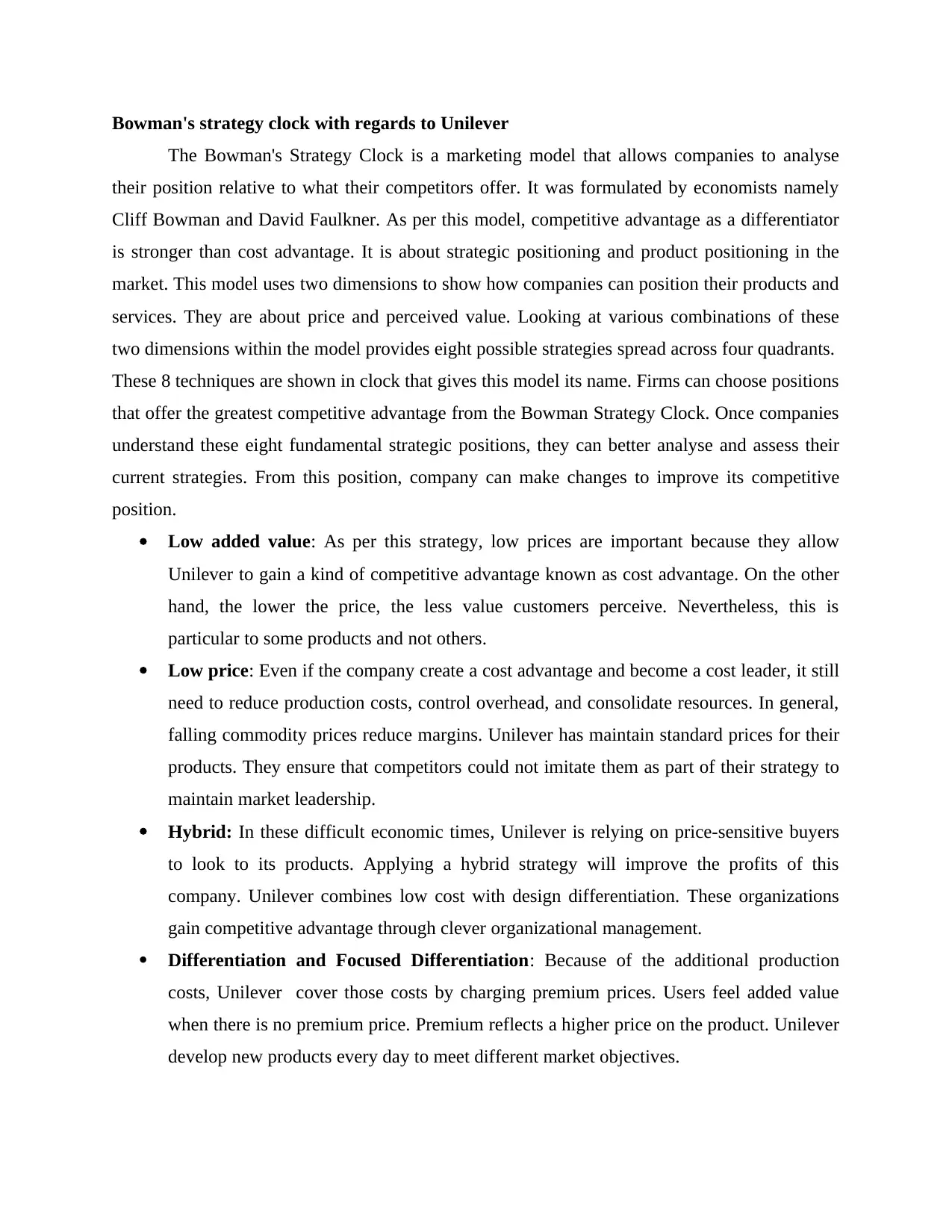
Bowman's strategy clock with regards to Unilever
The Bowman's Strategy Clock is a marketing model that allows companies to analyse
their position relative to what their competitors offer. It was formulated by economists namely
Cliff Bowman and David Faulkner. As per this model, competitive advantage as a differentiator
is stronger than cost advantage. It is about strategic positioning and product positioning in the
market. This model uses two dimensions to show how companies can position their products and
services. They are about price and perceived value. Looking at various combinations of these
two dimensions within the model provides eight possible strategies spread across four quadrants.
These 8 techniques are shown in clock that gives this model its name. Firms can choose positions
that offer the greatest competitive advantage from the Bowman Strategy Clock. Once companies
understand these eight fundamental strategic positions, they can better analyse and assess their
current strategies. From this position, company can make changes to improve its competitive
position.
Low added value: As per this strategy, low prices are important because they allow
Unilever to gain a kind of competitive advantage known as cost advantage. On the other
hand, the lower the price, the less value customers perceive. Nevertheless, this is
particular to some products and not others.
Low price: Even if the company create a cost advantage and become a cost leader, it still
need to reduce production costs, control overhead, and consolidate resources. In general,
falling commodity prices reduce margins. Unilever has maintain standard prices for their
products. They ensure that competitors could not imitate them as part of their strategy to
maintain market leadership.
Hybrid: In these difficult economic times, Unilever is relying on price-sensitive buyers
to look to its products. Applying a hybrid strategy will improve the profits of this
company. Unilever combines low cost with design differentiation. These organizations
gain competitive advantage through clever organizational management.
Differentiation and Focused Differentiation: Because of the additional production
costs, Unilever cover those costs by charging premium prices. Users feel added value
when there is no premium price. Premium reflects a higher price on the product. Unilever
develop new products every day to meet different market objectives.
The Bowman's Strategy Clock is a marketing model that allows companies to analyse
their position relative to what their competitors offer. It was formulated by economists namely
Cliff Bowman and David Faulkner. As per this model, competitive advantage as a differentiator
is stronger than cost advantage. It is about strategic positioning and product positioning in the
market. This model uses two dimensions to show how companies can position their products and
services. They are about price and perceived value. Looking at various combinations of these
two dimensions within the model provides eight possible strategies spread across four quadrants.
These 8 techniques are shown in clock that gives this model its name. Firms can choose positions
that offer the greatest competitive advantage from the Bowman Strategy Clock. Once companies
understand these eight fundamental strategic positions, they can better analyse and assess their
current strategies. From this position, company can make changes to improve its competitive
position.
Low added value: As per this strategy, low prices are important because they allow
Unilever to gain a kind of competitive advantage known as cost advantage. On the other
hand, the lower the price, the less value customers perceive. Nevertheless, this is
particular to some products and not others.
Low price: Even if the company create a cost advantage and become a cost leader, it still
need to reduce production costs, control overhead, and consolidate resources. In general,
falling commodity prices reduce margins. Unilever has maintain standard prices for their
products. They ensure that competitors could not imitate them as part of their strategy to
maintain market leadership.
Hybrid: In these difficult economic times, Unilever is relying on price-sensitive buyers
to look to its products. Applying a hybrid strategy will improve the profits of this
company. Unilever combines low cost with design differentiation. These organizations
gain competitive advantage through clever organizational management.
Differentiation and Focused Differentiation: Because of the additional production
costs, Unilever cover those costs by charging premium prices. Users feel added value
when there is no premium price. Premium reflects a higher price on the product. Unilever
develop new products every day to meet different market objectives.
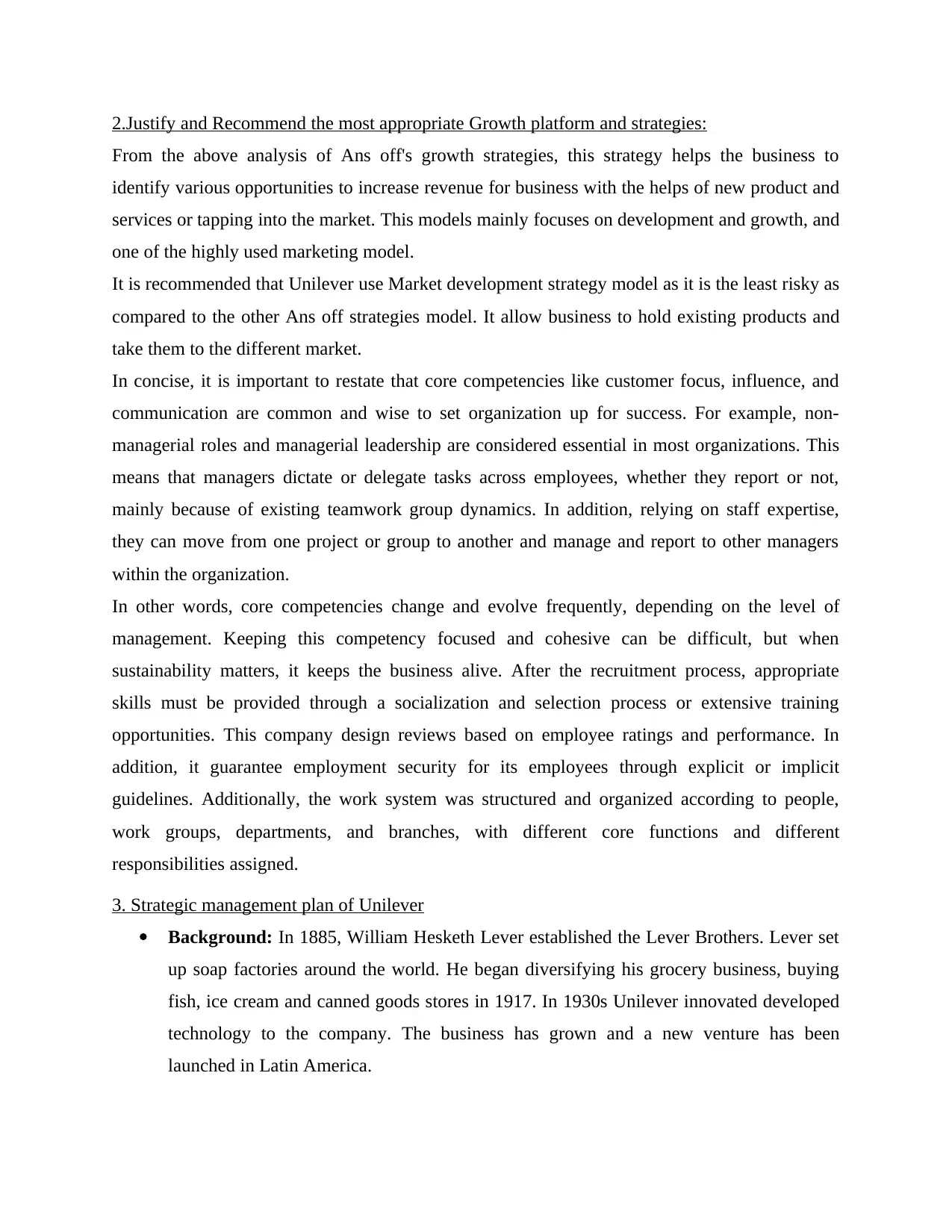
2.Justify and Recommend the most appropriate Growth platform and strategies:
From the above analysis of Ans off's growth strategies, this strategy helps the business to
identify various opportunities to increase revenue for business with the helps of new product and
services or tapping into the market. This models mainly focuses on development and growth, and
one of the highly used marketing model.
It is recommended that Unilever use Market development strategy model as it is the least risky as
compared to the other Ans off strategies model. It allow business to hold existing products and
take them to the different market.
In concise, it is important to restate that core competencies like customer focus, influence, and
communication are common and wise to set organization up for success. For example, non-
managerial roles and managerial leadership are considered essential in most organizations. This
means that managers dictate or delegate tasks across employees, whether they report or not,
mainly because of existing teamwork group dynamics. In addition, relying on staff expertise,
they can move from one project or group to another and manage and report to other managers
within the organization.
In other words, core competencies change and evolve frequently, depending on the level of
management. Keeping this competency focused and cohesive can be difficult, but when
sustainability matters, it keeps the business alive. After the recruitment process, appropriate
skills must be provided through a socialization and selection process or extensive training
opportunities. This company design reviews based on employee ratings and performance. In
addition, it guarantee employment security for its employees through explicit or implicit
guidelines. Additionally, the work system was structured and organized according to people,
work groups, departments, and branches, with different core functions and different
responsibilities assigned.
3. Strategic management plan of Unilever
Background: In 1885, William Hesketh Lever established the Lever Brothers. Lever set
up soap factories around the world. He began diversifying his grocery business, buying
fish, ice cream and canned goods stores in 1917. In 1930s Unilever innovated developed
technology to the company. The business has grown and a new venture has been
launched in Latin America.
From the above analysis of Ans off's growth strategies, this strategy helps the business to
identify various opportunities to increase revenue for business with the helps of new product and
services or tapping into the market. This models mainly focuses on development and growth, and
one of the highly used marketing model.
It is recommended that Unilever use Market development strategy model as it is the least risky as
compared to the other Ans off strategies model. It allow business to hold existing products and
take them to the different market.
In concise, it is important to restate that core competencies like customer focus, influence, and
communication are common and wise to set organization up for success. For example, non-
managerial roles and managerial leadership are considered essential in most organizations. This
means that managers dictate or delegate tasks across employees, whether they report or not,
mainly because of existing teamwork group dynamics. In addition, relying on staff expertise,
they can move from one project or group to another and manage and report to other managers
within the organization.
In other words, core competencies change and evolve frequently, depending on the level of
management. Keeping this competency focused and cohesive can be difficult, but when
sustainability matters, it keeps the business alive. After the recruitment process, appropriate
skills must be provided through a socialization and selection process or extensive training
opportunities. This company design reviews based on employee ratings and performance. In
addition, it guarantee employment security for its employees through explicit or implicit
guidelines. Additionally, the work system was structured and organized according to people,
work groups, departments, and branches, with different core functions and different
responsibilities assigned.
3. Strategic management plan of Unilever
Background: In 1885, William Hesketh Lever established the Lever Brothers. Lever set
up soap factories around the world. He began diversifying his grocery business, buying
fish, ice cream and canned goods stores in 1917. In 1930s Unilever innovated developed
technology to the company. The business has grown and a new venture has been
launched in Latin America.
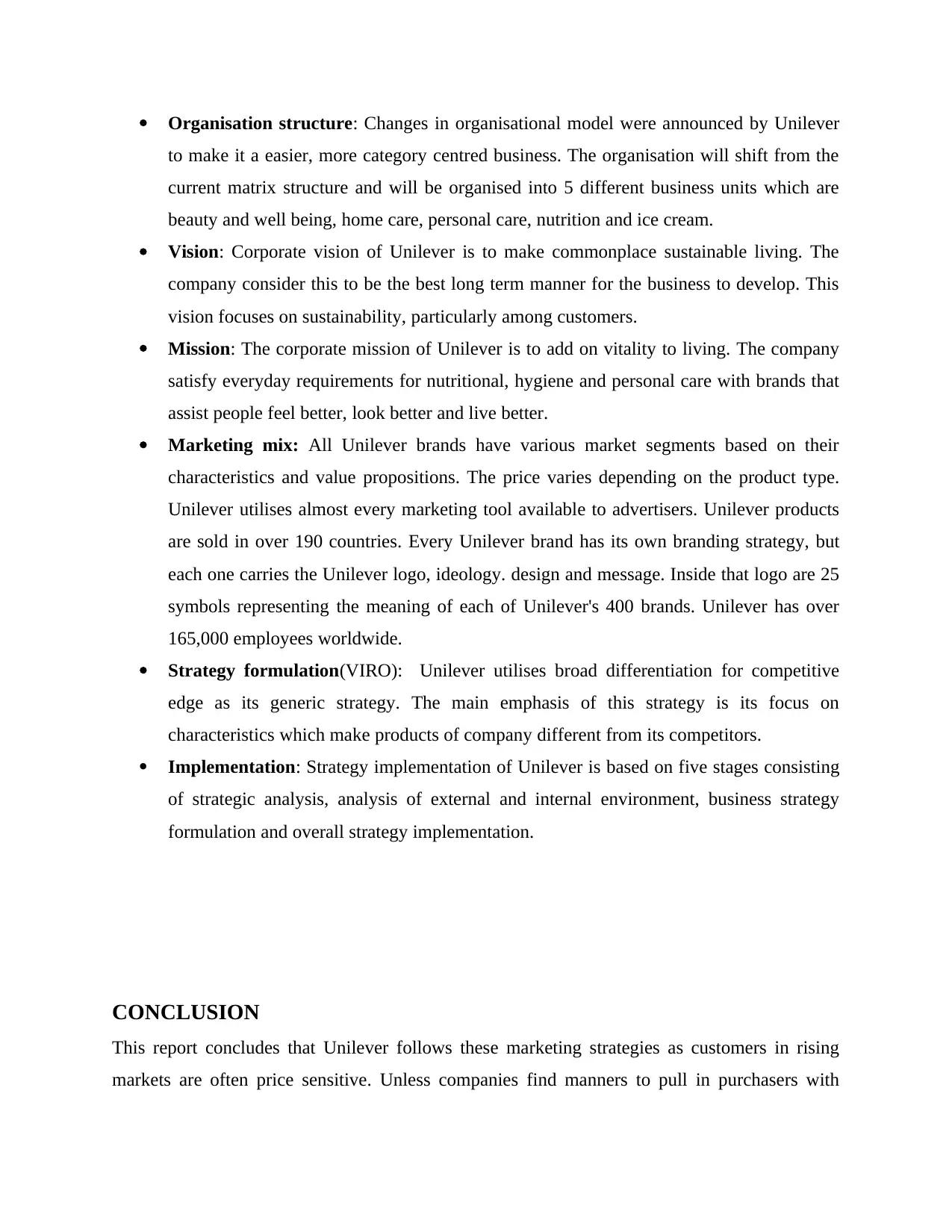
Organisation structure: Changes in organisational model were announced by Unilever
to make it a easier, more category centred business. The organisation will shift from the
current matrix structure and will be organised into 5 different business units which are
beauty and well being, home care, personal care, nutrition and ice cream.
Vision: Corporate vision of Unilever is to make commonplace sustainable living. The
company consider this to be the best long term manner for the business to develop. This
vision focuses on sustainability, particularly among customers.
Mission: The corporate mission of Unilever is to add on vitality to living. The company
satisfy everyday requirements for nutritional, hygiene and personal care with brands that
assist people feel better, look better and live better.
Marketing mix: All Unilever brands have various market segments based on their
characteristics and value propositions. The price varies depending on the product type.
Unilever utilises almost every marketing tool available to advertisers. Unilever products
are sold in over 190 countries. Every Unilever brand has its own branding strategy, but
each one carries the Unilever logo, ideology. design and message. Inside that logo are 25
symbols representing the meaning of each of Unilever's 400 brands. Unilever has over
165,000 employees worldwide.
Strategy formulation(VIRO): Unilever utilises broad differentiation for competitive
edge as its generic strategy. The main emphasis of this strategy is its focus on
characteristics which make products of company different from its competitors.
Implementation: Strategy implementation of Unilever is based on five stages consisting
of strategic analysis, analysis of external and internal environment, business strategy
formulation and overall strategy implementation.
CONCLUSION
This report concludes that Unilever follows these marketing strategies as customers in rising
markets are often price sensitive. Unless companies find manners to pull in purchasers with
to make it a easier, more category centred business. The organisation will shift from the
current matrix structure and will be organised into 5 different business units which are
beauty and well being, home care, personal care, nutrition and ice cream.
Vision: Corporate vision of Unilever is to make commonplace sustainable living. The
company consider this to be the best long term manner for the business to develop. This
vision focuses on sustainability, particularly among customers.
Mission: The corporate mission of Unilever is to add on vitality to living. The company
satisfy everyday requirements for nutritional, hygiene and personal care with brands that
assist people feel better, look better and live better.
Marketing mix: All Unilever brands have various market segments based on their
characteristics and value propositions. The price varies depending on the product type.
Unilever utilises almost every marketing tool available to advertisers. Unilever products
are sold in over 190 countries. Every Unilever brand has its own branding strategy, but
each one carries the Unilever logo, ideology. design and message. Inside that logo are 25
symbols representing the meaning of each of Unilever's 400 brands. Unilever has over
165,000 employees worldwide.
Strategy formulation(VIRO): Unilever utilises broad differentiation for competitive
edge as its generic strategy. The main emphasis of this strategy is its focus on
characteristics which make products of company different from its competitors.
Implementation: Strategy implementation of Unilever is based on five stages consisting
of strategic analysis, analysis of external and internal environment, business strategy
formulation and overall strategy implementation.
CONCLUSION
This report concludes that Unilever follows these marketing strategies as customers in rising
markets are often price sensitive. Unless companies find manners to pull in purchasers with
Paraphrase This Document
Need a fresh take? Get an instant paraphrase of this document with our AI Paraphraser
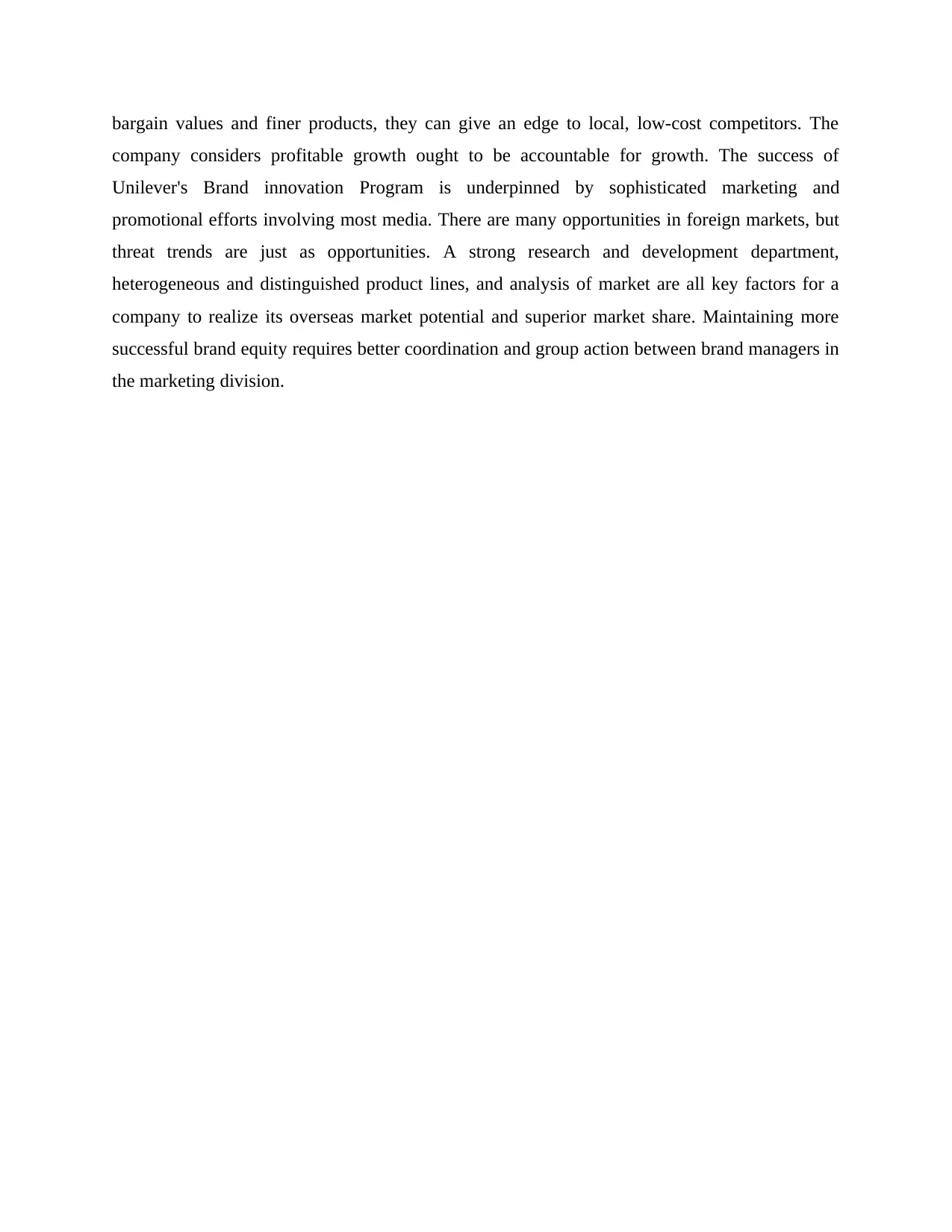
bargain values and finer products, they can give an edge to local, low-cost competitors. The
company considers profitable growth ought to be accountable for growth. The success of
Unilever's Brand innovation Program is underpinned by sophisticated marketing and
promotional efforts involving most media. There are many opportunities in foreign markets, but
threat trends are just as opportunities. A strong research and development department,
heterogeneous and distinguished product lines, and analysis of market are all key factors for a
company to realize its overseas market potential and superior market share. Maintaining more
successful brand equity requires better coordination and group action between brand managers in
the marketing division.
company considers profitable growth ought to be accountable for growth. The success of
Unilever's Brand innovation Program is underpinned by sophisticated marketing and
promotional efforts involving most media. There are many opportunities in foreign markets, but
threat trends are just as opportunities. A strong research and development department,
heterogeneous and distinguished product lines, and analysis of market are all key factors for a
company to realize its overseas market potential and superior market share. Maintaining more
successful brand equity requires better coordination and group action between brand managers in
the marketing division.
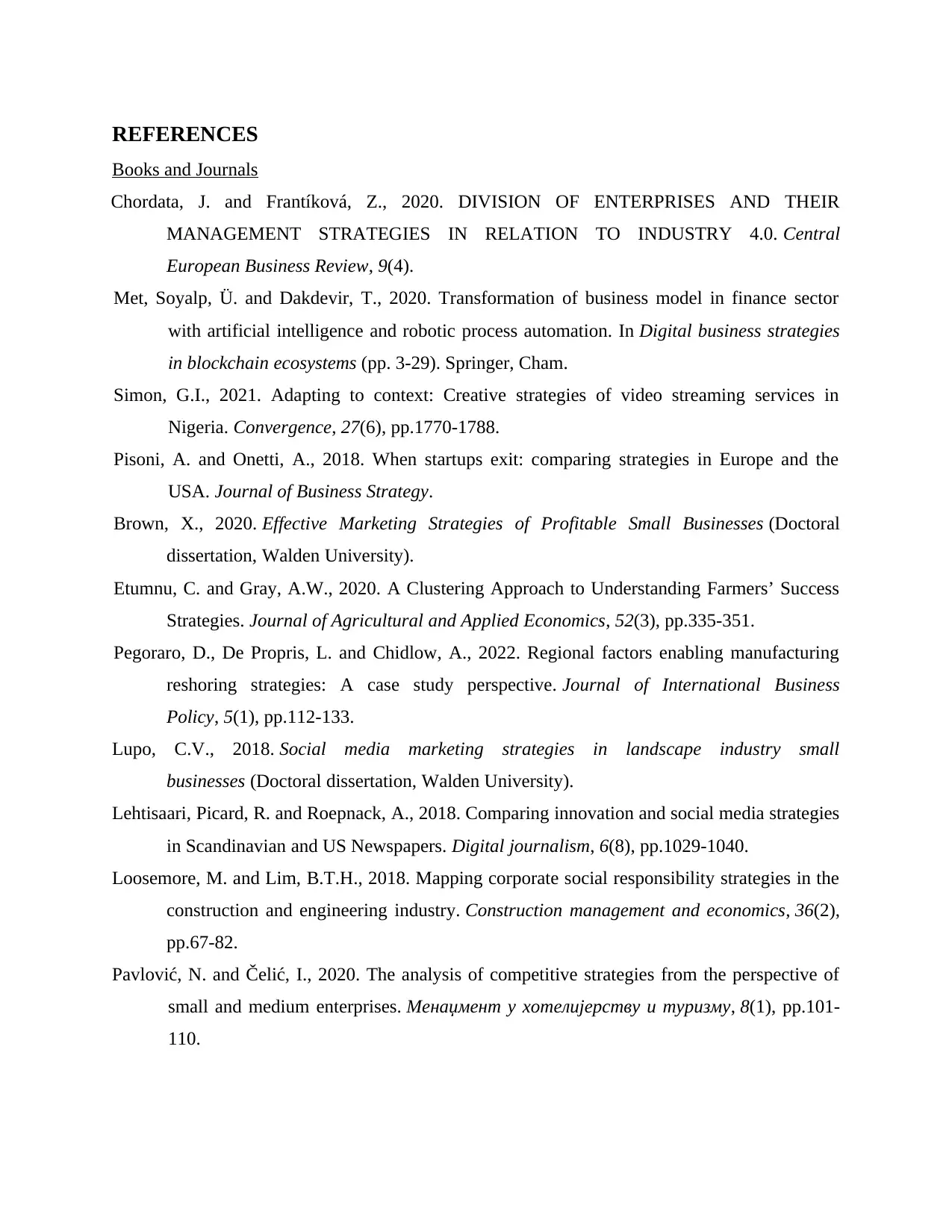
REFERENCES
Books and Journals
Chordata, J. and Frantíková, Z., 2020. DIVISION OF ENTERPRISES AND THEIR
MANAGEMENT STRATEGIES IN RELATION TO INDUSTRY 4.0. Central
European Business Review, 9(4).
Met, Soyalp, Ü. and Dakdevir, T., 2020. Transformation of business model in finance sector
with artificial intelligence and robotic process automation. In Digital business strategies
in blockchain ecosystems (pp. 3-29). Springer, Cham.
Simon, G.I., 2021. Adapting to context: Creative strategies of video streaming services in
Nigeria. Convergence, 27(6), pp.1770-1788.
Pisoni, A. and Onetti, A., 2018. When startups exit: comparing strategies in Europe and the
USA. Journal of Business Strategy.
Brown, X., 2020. Effective Marketing Strategies of Profitable Small Businesses (Doctoral
dissertation, Walden University).
Etumnu, C. and Gray, A.W., 2020. A Clustering Approach to Understanding Farmers’ Success
Strategies. Journal of Agricultural and Applied Economics, 52(3), pp.335-351.
Pegoraro, D., De Propris, L. and Chidlow, A., 2022. Regional factors enabling manufacturing
reshoring strategies: A case study perspective. Journal of International Business
Policy, 5(1), pp.112-133.
Lupo, C.V., 2018. Social media marketing strategies in landscape industry small
businesses (Doctoral dissertation, Walden University).
Lehtisaari, Picard, R. and Roepnack, A., 2018. Comparing innovation and social media strategies
in Scandinavian and US Newspapers. Digital journalism, 6(8), pp.1029-1040.
Loosemore, M. and Lim, B.T.H., 2018. Mapping corporate social responsibility strategies in the
construction and engineering industry. Construction management and economics, 36(2),
pp.67-82.
Pavlović, N. and Čelić, I., 2020. The analysis of competitive strategies from the perspective of
small and medium enterprises. Менаџмент у хотелијерству и туризму, 8(1), pp.101-
110.
Books and Journals
Chordata, J. and Frantíková, Z., 2020. DIVISION OF ENTERPRISES AND THEIR
MANAGEMENT STRATEGIES IN RELATION TO INDUSTRY 4.0. Central
European Business Review, 9(4).
Met, Soyalp, Ü. and Dakdevir, T., 2020. Transformation of business model in finance sector
with artificial intelligence and robotic process automation. In Digital business strategies
in blockchain ecosystems (pp. 3-29). Springer, Cham.
Simon, G.I., 2021. Adapting to context: Creative strategies of video streaming services in
Nigeria. Convergence, 27(6), pp.1770-1788.
Pisoni, A. and Onetti, A., 2018. When startups exit: comparing strategies in Europe and the
USA. Journal of Business Strategy.
Brown, X., 2020. Effective Marketing Strategies of Profitable Small Businesses (Doctoral
dissertation, Walden University).
Etumnu, C. and Gray, A.W., 2020. A Clustering Approach to Understanding Farmers’ Success
Strategies. Journal of Agricultural and Applied Economics, 52(3), pp.335-351.
Pegoraro, D., De Propris, L. and Chidlow, A., 2022. Regional factors enabling manufacturing
reshoring strategies: A case study perspective. Journal of International Business
Policy, 5(1), pp.112-133.
Lupo, C.V., 2018. Social media marketing strategies in landscape industry small
businesses (Doctoral dissertation, Walden University).
Lehtisaari, Picard, R. and Roepnack, A., 2018. Comparing innovation and social media strategies
in Scandinavian and US Newspapers. Digital journalism, 6(8), pp.1029-1040.
Loosemore, M. and Lim, B.T.H., 2018. Mapping corporate social responsibility strategies in the
construction and engineering industry. Construction management and economics, 36(2),
pp.67-82.
Pavlović, N. and Čelić, I., 2020. The analysis of competitive strategies from the perspective of
small and medium enterprises. Менаџмент у хотелијерству и туризму, 8(1), pp.101-
110.
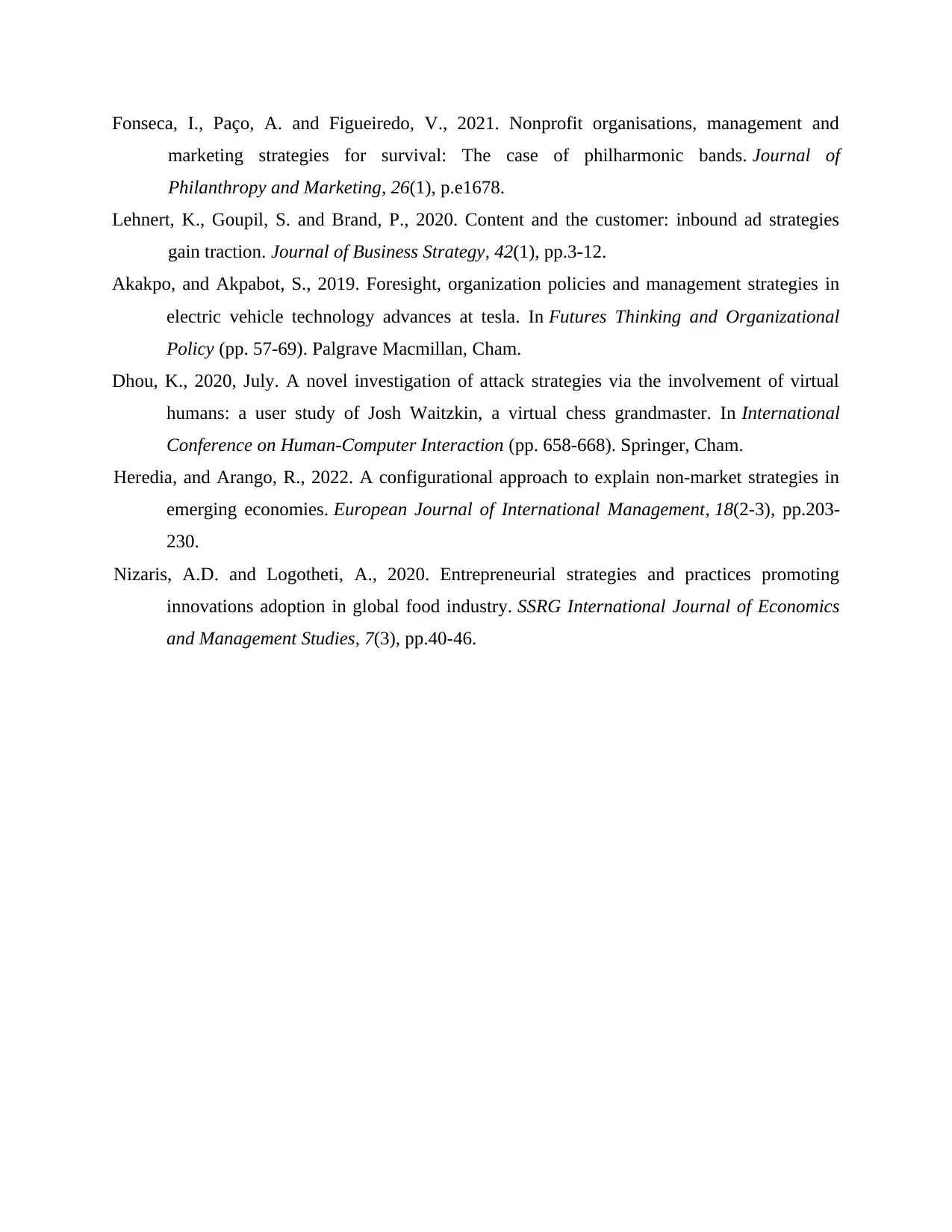
Fonseca, I., Paço, A. and Figueiredo, V., 2021. Nonprofit organisations, management and
marketing strategies for survival: The case of philharmonic bands. Journal of
Philanthropy and Marketing, 26(1), p.e1678.
Lehnert, K., Goupil, S. and Brand, P., 2020. Content and the customer: inbound ad strategies
gain traction. Journal of Business Strategy, 42(1), pp.3-12.
Akakpo, and Akpabot, S., 2019. Foresight, organization policies and management strategies in
electric vehicle technology advances at tesla. In Futures Thinking and Organizational
Policy (pp. 57-69). Palgrave Macmillan, Cham.
Dhou, K., 2020, July. A novel investigation of attack strategies via the involvement of virtual
humans: a user study of Josh Waitzkin, a virtual chess grandmaster. In International
Conference on Human-Computer Interaction (pp. 658-668). Springer, Cham.
Heredia, and Arango, R., 2022. A configurational approach to explain non-market strategies in
emerging economies. European Journal of International Management, 18(2-3), pp.203-
230.
Nizaris, A.D. and Logotheti, A., 2020. Entrepreneurial strategies and practices promoting
innovations adoption in global food industry. SSRG International Journal of Economics
and Management Studies, 7(3), pp.40-46.
marketing strategies for survival: The case of philharmonic bands. Journal of
Philanthropy and Marketing, 26(1), p.e1678.
Lehnert, K., Goupil, S. and Brand, P., 2020. Content and the customer: inbound ad strategies
gain traction. Journal of Business Strategy, 42(1), pp.3-12.
Akakpo, and Akpabot, S., 2019. Foresight, organization policies and management strategies in
electric vehicle technology advances at tesla. In Futures Thinking and Organizational
Policy (pp. 57-69). Palgrave Macmillan, Cham.
Dhou, K., 2020, July. A novel investigation of attack strategies via the involvement of virtual
humans: a user study of Josh Waitzkin, a virtual chess grandmaster. In International
Conference on Human-Computer Interaction (pp. 658-668). Springer, Cham.
Heredia, and Arango, R., 2022. A configurational approach to explain non-market strategies in
emerging economies. European Journal of International Management, 18(2-3), pp.203-
230.
Nizaris, A.D. and Logotheti, A., 2020. Entrepreneurial strategies and practices promoting
innovations adoption in global food industry. SSRG International Journal of Economics
and Management Studies, 7(3), pp.40-46.
1 out of 16
Related Documents
Your All-in-One AI-Powered Toolkit for Academic Success.
+13062052269
info@desklib.com
Available 24*7 on WhatsApp / Email
![[object Object]](/_next/static/media/star-bottom.7253800d.svg)
Unlock your academic potential
© 2024 | Zucol Services PVT LTD | All rights reserved.



